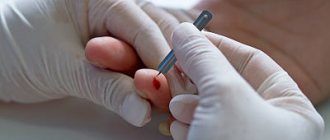How long is an HIV test valid and how often should you be tested? It is important to take precautions and check your status in a timely manner to increase your chances of a long, happy life and keep your loved ones safe.
A certificate that indicates the status of a sick or healthy patient is not just confirmation of a particular result, but a legal document. Therefore, how long HIV tests are valid is an important question. Despite the fact that you can be examined voluntarily, in some situations you have to be checked forcibly.
How long a blood test for HIV is valid depends on the goals being pursued. Where the certificate is required, its own expiration date for the document may be stated. But still, the results have a universal validity period, which is taken into account in most standard cases.
Why do a blood test for HIV and when is it necessary?
Why you need to do a blood test for HIV is clear. Identifying the disease in time means increasing the likelihood of survival. But sometimes circumstances force you to undergo an examination even if you have no doubt about the negative result of the test. How long is an HIV test valid and can it be done once for a lifetime? Unfortunately, the procedure will have to be repeated at certain intervals.
In what situations are people forced to test themselves for a disease?
- During pregnancy, women are recommended to test both parents for HIV;
- Future donors are certainly tested by ELISA;
- Medical workers who come into contact with the blood of patients are also required to undergo medical examinations with a certain frequency.
Types of blood and urine tests
Analyzes are classified into:
- General blood analysis. It will not make it possible to detect any specific disease, but will serve to identify inflammatory processes and infections. The general analysis serves as a starting point for further research.
- Blood chemistry. Its indicators determine the state of human organs and systems. Biochemistry results reflect the amount of chemical elements in the body.
- For sugar. Detects glucose levels and is used to determine diabetes.
- For tumor markers. With its help, elements of malignant formations are detected.
- Physicochemical analysis of urine. The results of this study reflect indicators such as acidity and specific gravity.
- Sediment microscopy for the presence of leukocytes, erythrocytes, salts and epithelium.
- Organoleptic – color, transparency and smell.
- Biochemical urine analysis. It is used to determine how much and what substances are released per day.
These are the most common types. In addition to the above, there are many more varieties. Some blood tests, for example, are taken to determine the presence of a specific infection. For example, for HIV or RW.
How long does an HIV test last and what influences this period?
How long does an HIV test last and what affects this indicator? There is a generally accepted average for each pathogen. In the case of HIV, this is 6 months. But there are nuances.
The laboratory to which the application was made can put its expiration date on the result form. This is justified on an individual basis. In fact, the results usually have a standard expiration date or simply indicate the date of the study.
If the analysis is carried out solely for submission to any institution, then a period of 6 months will not raise doubts or objections. If there are reasonable suspicions that the analysis turned out to be unreliable, then it makes sense to retake it within 4 weeks, and not wait six months, wasting precious time.
In what other cases will an analysis less than 6 calendar months old be considered valid:
- Pregnancy;
- Donation;
- Blood transfusion or organ transplant;
- Entering into work, service or study in certain structures;
- Submitting documents for citizenship.
Thus, it can be stated that validity periods are not always regulated by one single rule.
Time frame for preparation for analysis
It has already been clarified how valid an HIV test is; now it remains to remember that for the reliability of the analysis, you need to correctly approach the examination procedure itself. Analysis is rarely done hastily, without preparation. The patient is warned several days in advance; on average, 5 days are given for quality preparation.
There are certain requirements for lifestyle and daily routine during preparation. This will be discussed below. Of course, if necessary, the analysis is carried out without preparation. But then the doctor gives a recommendation to recheck the result at the earliest opportunity, following all instructions.
Responsibility for failure to comply with personal data protection requirements
Depending on the circumstances, in case of failure to comply with the requirements for the protection of personal data, a medical organization or its employees may be subject to disciplinary, civil, administrative or even criminal liability. Let's look at the most likely cases in the table:
| Norm | Description of the norm | Punishment | A comment |
| Criminal liability (Criminal Code of the Russian Federation - Criminal Code of the Russian Federation) | |||
| Art. 137 of the Criminal Code of the Russian Federation | Illegal collection or dissemination of information about the private life of a person, constituting his personal or family secret, without his consent, or dissemination of this information in a public speech, publicly displayed work or the media | Up to imprisonment for up to 4 years with deprivation of the right to hold medical positions or engage in medical activities for up to 5 years | In relation to the situation under consideration, liability under this article is unlikely and can only occur if the Criminal Code of the Russian Federation is incorrectly interpreted by the investigative authorities. Firstly, the mere transmission of medical confidentiality via electronic communication channels does not constitute their distribution. According to subparagraph 5 of Article 3 of Federal Law No. 152, dissemination of personal data is actions aimed at disclosing personal data to an indefinite number of persons. Therefore, the mere fact of sending PD via electronic channels is not enough - third parties must gain access to it. Secondly, a prerequisite for prosecution under this article is the presence of direct intent to disseminate personal data. It is quite difficult to prove such intent on the part of a medical worker. Strong evidence in favor of his innocence will be consent to the processing of personal data, in which, as we advised, the patient agrees to send research results by email. This document will indicate that the medical professional acted in the interests of the patient and did not set out to disseminate PD. |
| Administrative responsibility (Code of the Russian Federation on Administrative Offenses - Code of Administrative Offenses of the Russian Federation) | |||
| part 6 art. 13.12 Code of Administrative Offenses of the Russian Federation | Violation of information protection requirements <…> | Imposition of an administrative fine on citizens in the amount of 500 to 1,000 rubles; for officials - from 1,000 to 2,000 rubles; for legal entities - from 10,000 to 15,000 rubles | Responsibility under this article may arise, for example, for failure to comply with the very requirements of the ZIS.3. After depersonalization of PD, as well as when following our other recommendations, the risk of prosecution under this article is extremely low (for more details, see the comments above). |
| Art. 13.14 Code of Administrative Offenses of the Russian Federation | Disclosure of information, access to which is limited <…>, by a person who has gained access to such information in connection with the performance of official or professional duties | Imposition of an administrative fine on citizens in the amount of 500 to 1,000 rubles; for officials - from 4,000 to 5,000 rubles | In this case, the situation is similar to the one we considered in relation to Article 137 of the Criminal Code of the Russian Federation (see above) |
Seronegative window for HIV – what is it?
The dangerous period of the disease is the first phase. A person is already infected, it is impossible to cancel it, just as it is impossible to find out about the disease even with the help of an enzyme immunoassay. The latent stage is often asymptomatic; mild discomfort can be attributed to any other infections or abnormalities.
The undetectable period is dangerous mainly for family and friends. After all, not knowing about the disease, the carrier does not care about protecting others.
How to behave during the seronegative window
Correct behavior will help save the resources of your own body and protect your loved ones and loved ones. The rules are simple, but it wouldn’t hurt to remind them.
- Use condoms, practice only protected sex;
- Do not become a donor until you receive reliable data on your health status;
- Do not plan pregnancy and take precautions responsibly;
- Avoid using reusable medical instruments;
- It is advisable not to do figurative manicures or other procedures where the skin may be damaged;
- Be examined every 4 weeks until you receive a final reliable answer.
And, of course, we should not forget to take care of ourselves. The immune system does not need unnecessary burdens; it will need strength to fight the virus if it suddenly shows up.
Submission rules
To get the most correct result, you need to consider some. You will be given the correct diagnosis if you follow the following:
- Be sure to consult your doctor before taking the test.
- Be sure to wash yourself before drawing blood.
- Do not collect the very first urine.
- Collect urine only in a sterile and pre-prepared container.
- The container with the material must be quickly delivered to the laboratory.
Post Views: 3,246
Laboratory testing of urinary fluid is considered the safest form of diagnosing any disease. The shelf life of urine is the period during which it should be submitted for analysis in order to obtain a reliable result. This type of laboratory diagnostics is safe for adults and children. Therefore, you should know not only how to collect urine, but also how to store it.
What do you need to know before taking an HIV test?
Knowing the expiration date of HIV tests, you can plan the time of the test. It is recommended to choose a convenient time, preferably during a period when everything is calm at work and there are no holidays planned in the family. This will make it easier to follow all the recommendations for preparing for analysis.
Testing for the presence of virions in the blood is carried out in the laboratory. The biomaterial is taken from a vein, on an empty stomach, after preparation by the patient. It’s quite easy to prepare; no one makes any extremely difficult demands.
- 4-6 hours of fasting before blood sampling;
- Do not smoke for several hours;
- 2 days before visiting the clinic, stop drinking alcohol;
- Avoid fatty, high-calorie foods for 3-4 days.
Failure to comply with such a simple manifesto may lead to a false positive result, which means that several more similar trips to the medical center will lie ahead.
How long does a urine test take?
During the study of urine, its physical and chemical indicators are revealed: dissolved salts, the presence of blood, protein, microflora and others.
How long it will take to find out this data depends on each individual situation. As a rule, if you submit a urine test to the laboratory in the morning, the result will be ready within a few hours, but sometimes it may take several days to check the urine. Maximum accuracy when examining urine can be achieved only if the recommendations for preparation, collection and storage conditions of the material are followed.
General urine analysis
Designated to determine physical and chemical parameters
When examining, attention is paid to the presence of sediment, color, concentration, turbidity and acidity. By examining urine, you can identify pathological conditions at an early stage of development:
Information content depends on correctly collected material. The container for collecting liquid must be clean. Urine collection is carried out in the morning, before breakfast. The jar is kept cold, but it must be taken to the laboratory no later than 2 hours after collecting the material. The results can be collected the very next day. In cases requiring a quick response, it is processed within a few hours.
According to Zimnitsky
This study helps to obtain more detailed information about the performance of kidney function, the collection and removal of urine from the body. After conducting a study, they will find out the density and volume of urine that is released during the day. The material is collected in separate containers at a clearly defined time, which is indicated by the attending physician. Each jar is marked; the time of collection, serial number and personal information must be indicated. You won’t have to wait long for an answer; the final data will be ready in a day.
Quantitative methods
If a general urinalysis is aimed at identifying a large number of parameters, then these methods determine the values of leukocytes, erythrocytes, and cylinders per unit of liquid over a period of time. Such tests make it possible to diagnose renal pathologies, monitor the complexity of their course and monitor their treatment.
https://youtube.com/watch?v=vbkh8sFPwH0
According to Nechiporenko
The ease of implementation and the undemanding nature of the method for laboratory equipment have made it the most popular. It is carried out when deviations in the OAM are detected. The point of the analysis is to count red blood cells, leukocytes and casts per 1 ml of urine. To do this, morning urine is collected immediately after waking up, and no later than 2 hours later it is delivered to the laboratory to calculate the results. The research is carried out as follows:
- the material is mixed and, having selected 10 ml, placed in a special test tube;
- the measuring flask is placed in the apparatus, where it remains for about 3 minutes;
- at the end of the treatment, only 1 ml of urine, which contains sediment, is left in the flask;
- The grounds are mixed and sent to a counting device under a microscope.
Correct interpretation of indicators is important. Cellular composition: red blood cells, leukocytes and casts (protein casts), counted separately
The timing of receiving results may vary. They depend on the workload of the laboratory, but on average one analysis is completed within 7 hours. A person picks up the prepared information after 1 business day.
Semi-quantitative
For urine analysis, special test strips are used that are sensitive to protein. Bromophenol blue is the main chemical they contain. The proportion of protein in the urine is determined by the degree of coloration of the strips. Therefore, visual assessment most often predominates, although special analyzers can be used. The advantage of such an analysis is that you don’t have to wait long for information, but its assessment is always equivalent to an approximate one.
If the patient's health is critical, the doctor needs quick laboratory results, so blood and urine tests are done in a few minutes.
Qualitative tests
They are used when it is necessary to determine protein in urine. Under the influence of special chemical reagents or physical factors, the protein molecule changes. As a result, the urine becomes cloudy or sediment appears in the form of flakes. There are 3 qualitative methods:
- Heller's test;
- use of sulfosalic acid;
- boiling.
The results obtained are not considered reliable. To determine proteinuria, the Heller test and sulfosalic acid are often used. The boiling method is rarely used. The final data will take several days to be prepared. In a private clinic, the period for receiving a transcript form is about 2 days, and in a public clinic, a person will receive a table within a week.
Expiry date of HIV test
The long shelf life of the HIV test allows you to plan the test in advance and not rush to get the result. In government institutions, the waiting time is several days, often up to 2 weeks. Paid clinics and laboratories are able to provide a document with the result urgently, within 1-2 hours.
How valid is an HIV test in a given case? It would be a good idea to consult in advance where the certificate is required. The standard 6 months of validity of the certificate increases to 1 year if we are talking about the production of a medical book. In other cases, the shelf life either remains standard or may be reduced.
Table “Validity periods of blood tests”
HIV The shelf life of an HIV test differs from that for other diseases. The period of action is established based on the characteristics of the course of the disease, pathogenesis and rate of spread of infection.
Medical test results are medical confidentiality
Let's start with the fact that information about the fact that a citizen applied for medical care, his state of health and diagnosis, as well as other information obtained during his medical examination and treatment, constitutes a medical secret (Part 1 of Article 13 of the Federal Law of November 21, 2011 No. 323-FZ “On the fundamentals of protecting the health of citizens in the Russian Federation” (hereinafter referred to as Federal Law No. 323)).
Obviously, the test result can be attributed both to information about the patient’s diagnosis and to other information obtained during a medical examination of a citizen. Moreover, according to paragraphs. 4 and 3 tbsp. 2 Federal Law No. 323, diagnosis of a disease is also included in the concept of “medical care”, therefore, even the very fact of a citizen applying for testing can be classified as information constituting a medical secret (not to mention the results of such testing).
Here it is necessary to clarify that medical confidentiality is a special category of personal data. Consequently, the handling of information constituting medical confidentiality is also regulated by Federal Law No. 152-FZ of July 27, 2006 “On Personal Data” (hereinafter referred to as Federal Law No. 152). Next, for a deeper understanding of the issue, let’s understand the concepts a little:
- Thus, according to subparagraph 1 of Article 3 of Federal Law No. 152, any information relating directly or indirectly to a specific or identifiable individual (subject of personal data) is personal data.
- In turn, based on paragraph 1 of Article 10 of Federal Law No. 152, personal data relating to health belongs to a special category of personal data (PD).
- A medical organization (including a laboratory taking a test) is a PD operator (see subparagraph 2 of Article 3 of Federal Law No. 152).
- Any actions performed with personal data, including collection, recording, systematization, accumulation, storage, clarification (updating, changing), extraction, use, transfer (distribution, provision, access), depersonalization, blocking, deletion, destruction are related to the processing of personal data. data.
Therefore, the transmission of diagnostic test results by email constitutes the processing of personal data. In this case, the medical organization performs the functions of a PD operator and must meet certain requirements specified in Federal Law No. 152. Including:
- Subclause 1 of clause 1 of Article 6, according to which the processing of personal data is carried out with the consent of the subject of personal data to the processing of his personal data. Please note that in relation to a special category of personal data relating to health, such consent is given in writing (subclause 1 of clause 2 of Article 10 of Federal Law No. 152).
- Article 19, according to which the operator, when processing personal data, is obliged to take the necessary measures to protect personal data (more on this below).
Many medical organizations limit themselves to obtaining only written consent to process personal data. However, as we see, the legislator’s requirements for PD operators are not limited to this. This, in fact, lies the answer to the main question - is it legal to transmit test results by email or SMS. Let's take a closer look at Article 19 of Federal Law No. 152.










